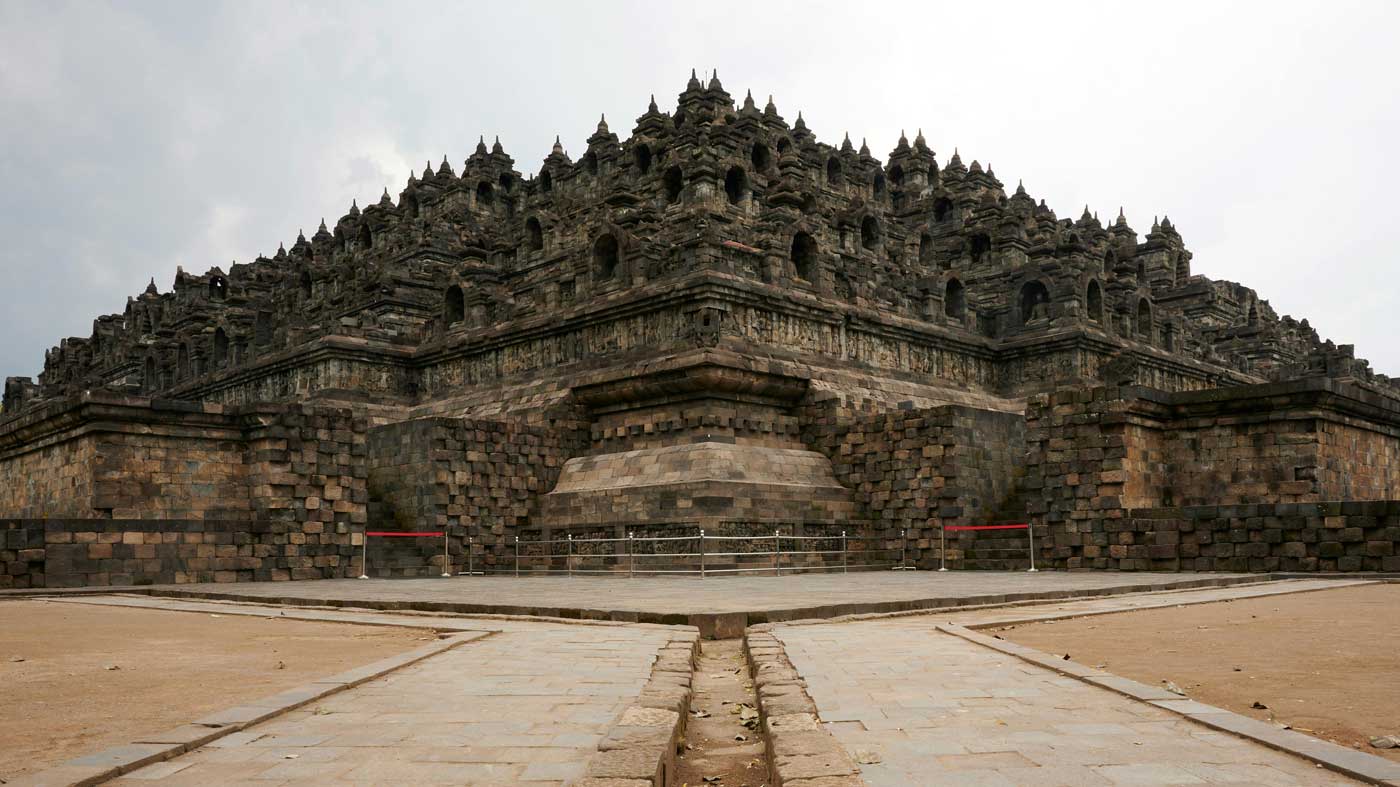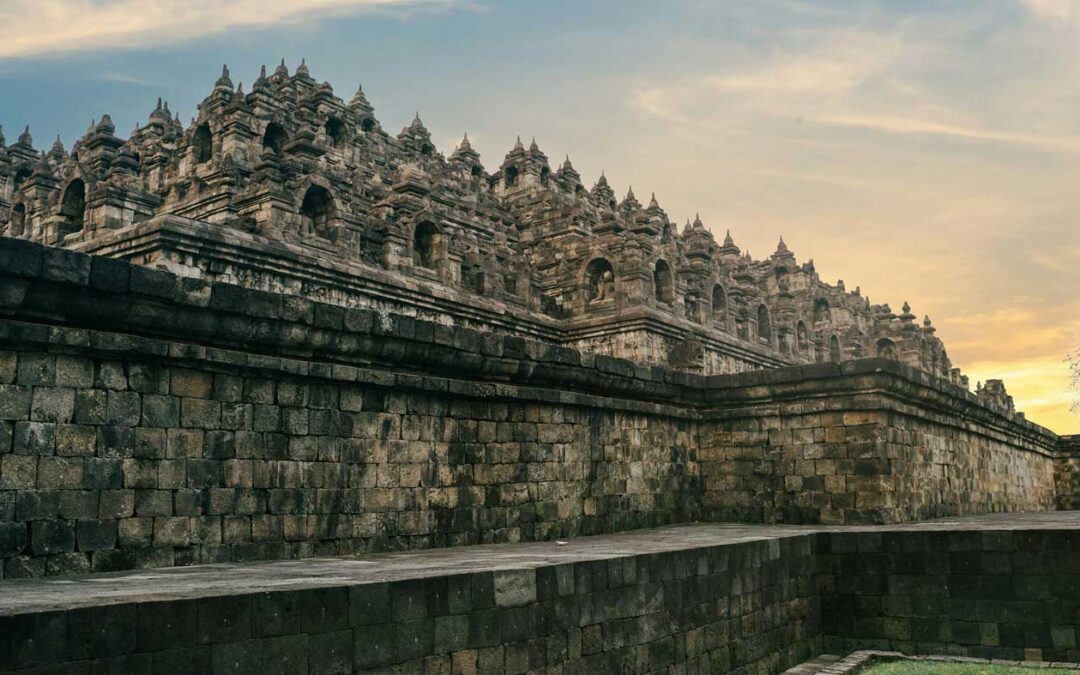The world’s largest Buddhist temple is Borobudur, located in Central Java, Indonesia. This magnificent structure is a UNESCO World Heritage Site and is renowned for its intricate architecture, historical significance, and spiritual importance. Here’s a detailed overview of Borobudur:
History and Significance of the World’s Largest Buddhist Temple:
- Construction: Borobudur was constructed during the reign of the Sailendra Dynasty around the 8th and 9th centuries CE.
- Rediscovery: Over time, the temple was buried under layers of volcanic ash and jungle growth until it was rediscovered and underwent major restoration efforts in the 19th century under British and Dutch guidance.
- UNESCO Designation: In 1991, Borobudur was designated a UNESCO World Heritage Site, celebrating its cultural and historical importance. Visit the Borobudur page on the UNESCO website
Architectural Features:
- Structure: The temple is a large stupa in the form of a mandala, symbolizing Buddhist cosmology and the path to enlightenment.
- Design: It is built in the shape of a massive symmetrical stupa, decorated with 2,672 relief panels and 504 Buddha statues.
- Levels: The structure consists of nine stacked platforms, six square and three circular, topped by a central dome. The design represents the three realms of Buddhist cosmology: Kamadhatu (the world of desire), Rupadhatu (the world of forms), and Arupadhatu (the formless world).
Religious and Cultural Importance:
- Pilgrimage Site: Borobudur is an important pilgrimage site for Buddhists and a popular tourist destination, attracting practitioners and visitors worldwide.
- Vesak Day: It serves as the focal point for Vesak Day celebrations, an important Buddhist holiday that commemorates the birth, enlightenment, and death of Buddha.
Restoration and Conservation:
- Restoration Projects: Significant restoration efforts, particularly those sponsored by UNESCO in the late 20th century, have helped stabilize the structure and preserve its intricate carvings.
- Conservation Challenges: Efforts continue to address challenges such as erosion, visitor impact, and environmental factors to preserve this site for future generations.

The Largest Buddist temple in the world is located in Indonesia
Visiting Borobudur, the Largest Buddhist Temple in the World:
- Access: Borobudur is approximately 40 kilometers northwest of Yogyakarta, and visitors can reach it by car or organized tours.
- Experience: Visitors often explore the temple by walking around the platforms in a clockwise direction, in accordance with Buddhist tradition, taking in the visual narrative of the reliefs and statues.
- Best Time to Visit: Sunrise visits are particularly popular, offering a breathtaking view as the sun rises over the lush landscape and illuminates the temple.
Borobudur stands as a testament to the architectural and artistic achievements of its time, embodying deep spiritual and cultural significance. Its grandeur and intricate design continue to inspire awe and reverence among those who visit, making it a must-see destination for travelers interested in history, architecture, and spirituality.
Frequently Asked Questions (FAQs) about Borobudur, the World’s Largest Buddhist Temple:
Q1: What is Borobudur?
- A1: Borobudur is the world’s largest Buddhist temple, located in Central Java, Indonesia. It is a massive structure built in the form of a stepped pyramid, serving as an important religious and cultural monument.
Q2: When was Borobudur built?
- A2: Borobudur was constructed during the 8th and 9th centuries CE under the reign of the Sailendra Dynasty.
Q3: What does Borobudur represent?
- A3: The temple is designed to symbolize the Buddhist path to enlightenment. It represents Buddhist cosmology, with three levels: Kamadhatu (the world of desire), Rupadhatu (the world of forms), and Arupadhatu (the formless world).
Q4: How do you visit Borobudur?
- A4: Borobudur is located about 40 kilometers northwest of Yogyakarta, Indonesia. It can be accessed by road via car or bus, and many tours offer guided visits.
Q5: What is unique about Borobudur’s architecture?
- A5: Borobudur features 2,672 relief panels and 504 Buddha statues across its nine stacked platforms. Its vast scale and intricate carvings make it a stunning example of Buddhist architecture.
Q6: Is Borobudur a UNESCO World Heritage Site?
- A6: Yes, Borobudur was designated a UNESCO World Heritage Site in 1991, recognizing its historical and cultural significance. Visit the UNESCO listing here.
Q7: What kind of activities can you do at Borobudur?
- A7: Visitors can explore the temple by walking clockwise around the platforms. Sunrise visits are particularly popular for watching the sun illuminate the structure and surrounding landscape.
Q8: When is the best time to visit Borobudur?
- A8: The dry season between April and October is generally the best time to visit to avoid rain. Early morning visits are recommended for cooler temperatures and quieter exploration.
Q9: Are there any events at Borobudur?
- A9: Yes, Borobudur is the focal point for Vesak Day celebrations, commemorating the birth, enlightenment, and death of Buddha with ceremonies and lantern releases.
Q10: What should I wear when visiting Borobudur?
- A10: As a place of worship and cultural heritage, it is recommended to wear modest clothing. Sarongs are often provided at the entrance for visitors to cover their legs.

